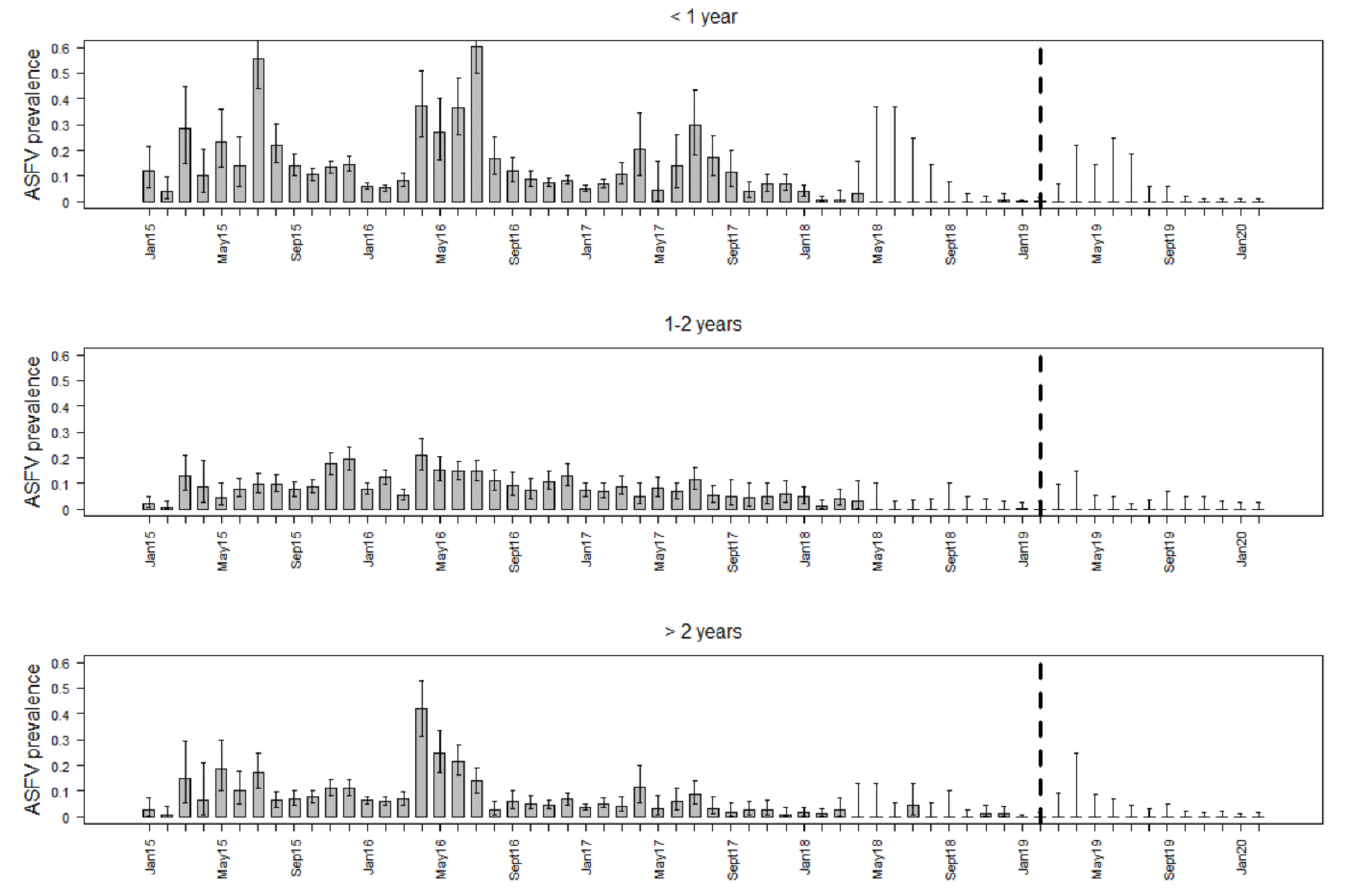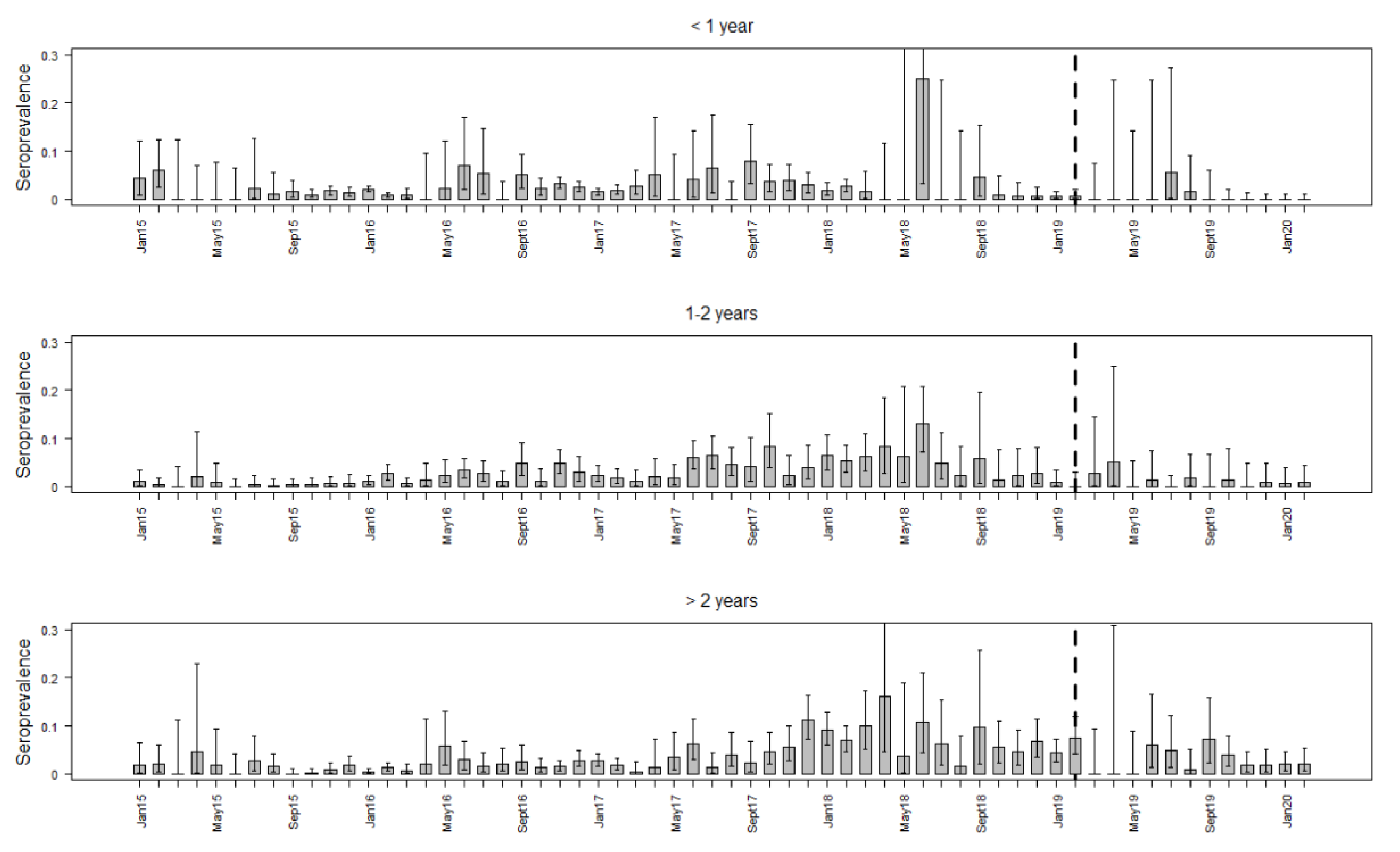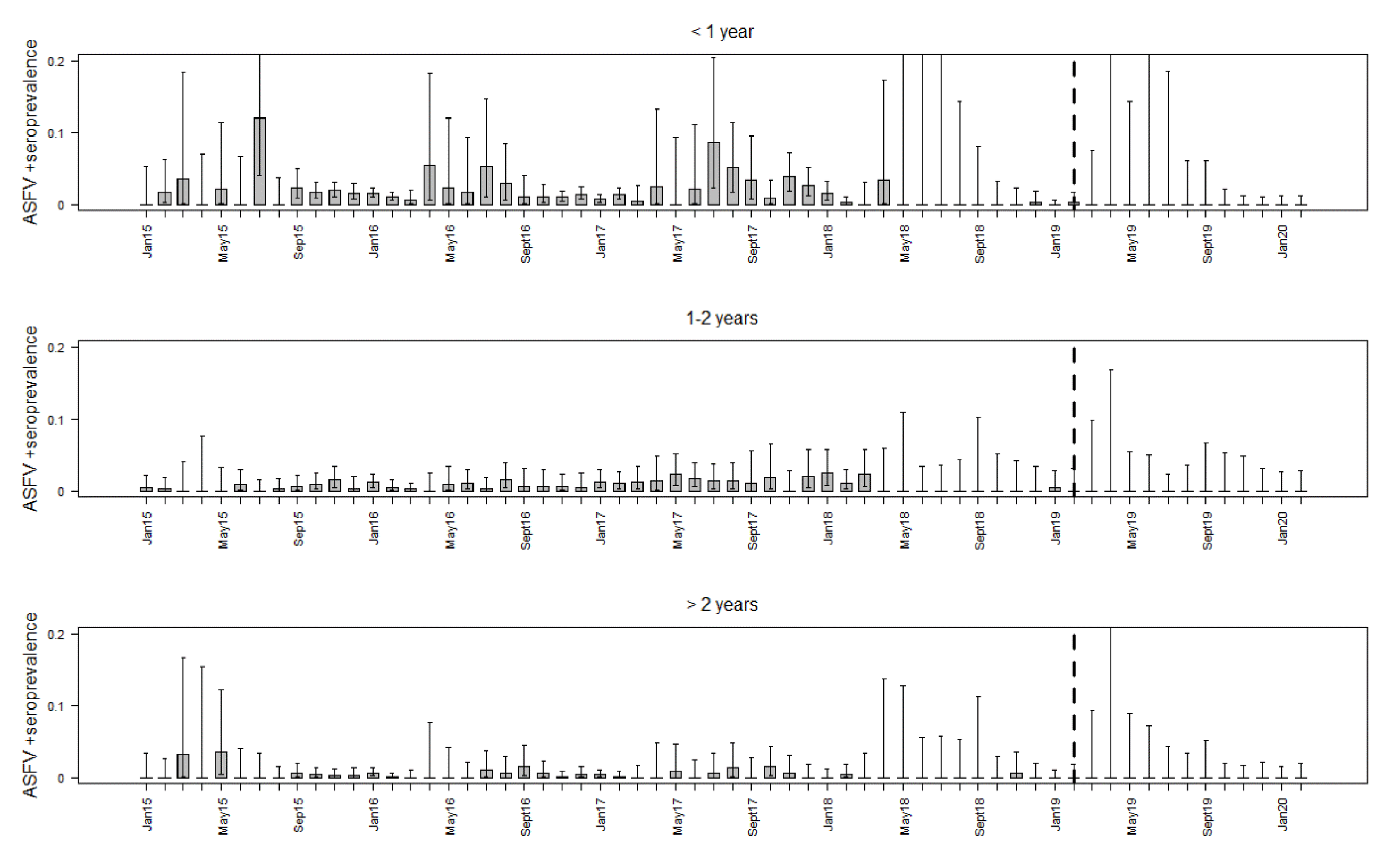How to Demonstrate Freedom from African Swine Fever in Wild Boar—Estonia as an Example
Abstract
:1. Introduction
2. Materials and Methods
2.1. Data
2.2. Prevalence Analyses
2.3. Modeling Temporal Effect
2.4. Population Density
3. Results
3.1. Data
3.2. Prevalence Analyses
3.3. Modeling Temporal Effect
3.4. Population Density
4. Discussion
5. Conclusions
Supplementary Materials
Author Contributions
Funding
Conflicts of Interest
References
- Nurmoja, I.; Mõtus, K.; Kristian, M.; Niine, T.; Schulz, K.; Depner, K.; Viltrop, A. Epidemiological analysis of the 2015–2017 African swine fever outbreaks in Estonia. Prev. Vet. Med. 2018, in press. [Google Scholar] [CrossRef]
- World Organisation for Animal Health. Terrestrial Animal Health Code. Volume I: General Provisions; OIE: Paris, France, 2019. [Google Scholar]
- World Organisation for Animal Health. Terrestrial Animal Health Code. Volume I: General Provisions; OIE: Paris, France, 2013. [Google Scholar]
- Sanchez-Vizcaino, J.M.; Mur, L.; Bastes, A.D.S.; Penrith, M.L. New insights into the role of ticks in African swine fever epidemiology. Rev. Sci. Tech. 2015, 34, 503–511. [Google Scholar] [CrossRef] [Green Version]
- World Organisation for Animal Health. Manual of Diagnostic Tests and Vaccines for Terrestrial Animals; World Organisation for Animal Health: Paris, France, 2018; pp. 1067–1068. [Google Scholar]
- Nurmoja, I.; Schulz, K.; Staubach, C.; Sauter-Louis, C.; Depner, K.; Conraths, F.J.; Viltrop, A. Development of African swine fever epidemic among wild boar in Estonia—two different areas in the epidemiological focus. Sci. Rep. 2017, 7, 12562. [Google Scholar] [CrossRef] [Green Version]
- Schulz, K.; Conraths, F.J.; Blome, S.; Staubach, C.; Sauter-Louis, C. African Swine Fever: Fast and Furious or Slow and Steady? Viruses 2019, 11, 866. [Google Scholar] [CrossRef] [Green Version]
- Zani, L.; Forth, J.H.; Forth, L.; Nurmoja, I.; Leidenberger, S.; Henke, J.; Carlson, J.; Breidenstein, C.; Viltrop, A.; Hoper, D.; et al. Deletion at the 5 ‘-end of Estonian ASFV strains associated with an attenuated phenotype. Sci. Rep. 2018, 8, 6510. [Google Scholar] [CrossRef]
- Petrov, A.; Forth, J.H.; Zani, L.; Beer, M.; Blome, S. No evidence for long-term carrier status of pigs after African swine fever virus infection. Transbound. Emerg. Dis. 2018, 65, 1318–1328. [Google Scholar] [CrossRef]
- Schulz, K.; Staubach, C.; Blome, S.; Viltrop, A.; Nurmoja, I.; Conraths, F.J.; Sauter-Louis, C. Analysis of Estonian surveillance in wild boar suggests a decline in the incidence of African swine fever. Sci. Rep. 2019, 9, 8490. [Google Scholar] [CrossRef] [PubMed]
- Gavier-Widen, D.; Stahl, K.; Dixon, L. No hasty solutions for African swine fever. Science 2020, 367, 622–624. [Google Scholar] [CrossRef] [PubMed]
- Sang, H.; Miller, G.; Lokhandwala, S.; Sangewar, N.; Waghela, S.D.; Bishop, R.P.; Mwangi, W. Progress Toward Development of Effective and Safe African Swine Fever Virus Vaccines. Front. Vet. Sci. 2020, 7, 84. [Google Scholar] [CrossRef] [PubMed]
- Penrith, M.L.; Thomson, G.R.; Bastos, A.D.S.; Phiri, O.C.; Lubisi, B.A.; Du Plessis, E.C.; Macome, F.; Pinto, F.; Botha, B.; Esterhuysen, J. An investigation into natural resistance to African swine fever in domestic pigs from an endemic area in southern Africa. Rev. Sci. Tech. 2004, 23, 965–977. [Google Scholar] [CrossRef]
- Pujols Romeu, J.; Badiola Saiz, J.I.; Perez de Rozas, A.M.; Rosell Bellsola, R.; Carreras Mauri, J. Papel que tienen los cerdos portadores en el mantenimientoy transmisión del virus de la PPA. l. Estudio epizootiológico. Med. Vet. 1991, 8, 481–489. [Google Scholar]
- Artois, M.; Depner, K.R.; Guberti, V.; Hars, J.; Rossi, S.; Rutili, D. Classical swine fever (hog cholera) in wild boar in Europe. Rev. Sci. Tech. Off. Int. Epizoot. 2002, 21, 287–303. [Google Scholar] [CrossRef] [PubMed] [Green Version]
- Dewulf, J.; Laevens, H.; Koenen, F.; Mintiens, K.; De Kruif, A. An experimental infection with classical swine fever virus in pregnant sows: Transmission of the virus, course of the disease, antibody response and effect on gestation. J. Vet. Med. Ser. B Infect. Dis. Vet. Public Health 2001, 48, 583–591. [Google Scholar] [CrossRef] [PubMed]
- Penrith, M.L.; Vosloo, W. Review of African swine fever: Transmission, spread and control. J. S. Afr. Vet. Assoc. 2009, 80, 58–62. [Google Scholar] [CrossRef] [PubMed] [Green Version]
- Sanchez Botija, C. African swine fever. New developments. Rev. Sci. Tech. Off. Int. Epizoot. 1982, 1, 991–1094. [Google Scholar] [CrossRef] [Green Version]
- Walczak, M.; Frant, M.; Juszkiewicz, M.; Mazur-Panasiuk, N.; Szymankiewicz, K.; Bruczynska, M.; Wozniakowski, G. Vertical transmission of anti-ASFV antibodies as one of potential causes of seropositive results among young wild boar population in Poland. Pol. J. Vet. Sci. 2020, 23, 21–25. [Google Scholar] [CrossRef]
- Costard, S.; Wieland, B.; de Glanville, W.; Jori, F.; Rowlands, R.; Vosloo, W.; Roger, F.; Pfeiffer, D.U.; Dixon, L.K. African swine fever: How can global spread be prevented? Philos. Trans. R. Soc. B-Biol. Sci. 2009, 364, 2683–2696. [Google Scholar] [CrossRef]
- Schlafer, D.H.; Mebus, C.A. Abortion in Sows Experimentally Infected with African Swine Fever Virus—Clinical-Features. Am. J. Vet. Res. 1984, 45, 1353–1360. [Google Scholar]
- Gallardo, C.; Fernandez-Pinero, J.; Arias, M. African swine fever (ASF) diagnosis, an essential tool in the epidemiological investigation. Virus Res. 2019, 271, 197676. [Google Scholar] [CrossRef]
- Stahl, K.; Sternberg-Lewerin, S.; Blome, S.; Viltrop, A.; Penrith, M.L.; Chenais, E. Lack of evidence for long term carriers of African swine fever virus—A systematic review. Virus Res. 2019, 272, 197725. [Google Scholar] [CrossRef]
- European Food Safety Authority. Epidemiological analyses of African swine fever in the European Union (November 2018 to October 2019). EFSA J. 2020, 18, 5996. [Google Scholar]
- Oļševskis, E.; Schulz, K.; Staubach, C.; Serzants, M.; Lamberga, K.; Pūle, D.; Ozoliņš, J.; Conraths, F.J.; Sauter-Louis, C. African swine fever in Latvian wild boar—A big step closer to eradication. Transbound. Emerg. Dis. 2020. submitted. [Google Scholar]
- Rossi, S.; Staubach, C.; Blome, S.; Guberti, V.; Thulke, H.H.; Vos, A.; Koenen, F.; Le Potier, M.F. Controlling of CSFV in European wild boar using oral vaccination: A review. Front. Microbiol. 2015, 6, 1141. [Google Scholar] [CrossRef] [PubMed]
- R Core Team. R: A Language and Environment for Statistical Computing; R Foundation for Statistical Computing: Vienna, Austria, 2015. [Google Scholar]
- Clopper, C.J.; Pearson, E.S. The use of confidence or fiducial limits illustrated in the case of the binomial. Biometrika 1935, 26, 404–413. [Google Scholar] [CrossRef]
- Staubach, C.; Hoffmann, L.; Schmid, V.J.; Ziller, M.; Tackmann, K.; Conraths, F.J. Bayesian space-time analysis of Echinococcus multilocularis-infections in foxes. Vet. Parasitol. 2011, 179, 77–83. [Google Scholar] [CrossRef] [PubMed]
- Sanchez-Vizcaino, J.M.; Mur, L.; Martinez-Lopez, B. African Swine Fever: An Epidemiological Update. Transbound. Emerg. Dis. 2012, 59, 27–35. [Google Scholar] [CrossRef]
- Mur, L.; Boadella, M.; Martinez-Lopez, B.; Gallardo, C.; Gortazar, C.; Sanchez-Vizcaino, J.M. Monitoring of African Swine Fever in the Wild Boar Population of the Most Recent Endemic Area of Spain. Transbound. Emerg. Dis. 2012, 59, 526–531. [Google Scholar] [CrossRef]
- Arias, M.; Sánchez-Vizcaíno, J.; Morilla, A.; Yoon, K.-J.; Zimmerman, J. African Swine Fever Eradication: The Spanish Model. African Swine Fever Eradication: The Spanish Model. Trends in Emerging Viral Infections of Swine; Iowa State Press: Iowa City, IA, USA, 2002; pp. 133–139. [Google Scholar]
- Perez, J.; Fernandez, A.I.; Sierra, M.A.; Herraez, P.; Fernandez, A.; de la Mulas, J.M. Serological and immunohistochemical study of African swine fever in wild boar in Spain. Vet. Rec. 1998, 143, 136–139. [Google Scholar] [CrossRef]
- Bech-Nielsen, S.; Fernandez, J.; Martinez-Pereda, F.; Espinosa, J.; Bonilla, Q.P.; Sanchez-Vizcaino, J.M. A case-study of an outbreak of African Swine Fever in Spain. Br. Vet. J. 1995, 151, 203–214. [Google Scholar] [CrossRef]
- Laddomada, A.; Rolesu, S.; Loi, F.; Cappai, S.; Oggiano, A.; Madrau, M.P.; Sanna, M.L.; Pilo, G.; Bandino, E.; Brundu, D.; et al. Surveillance and control of African Swine Fever in free-ranging pigs in Sardinia. Transbound. Emerg. Dis. 2019, 66, 1114–1119. [Google Scholar] [CrossRef] [Green Version]
- Loi, F.; Cappai, S.; Coccollone, A.; Rolesu, S. Standardized Risk Analysis Approach Aimed to Evaluate the Last African Swine Fever Eradication Program Performance, in Sardinia. Front. Vet. Sci. 2019, 6, 299. [Google Scholar] [CrossRef] [PubMed]
- Kaden, V.; Kramer, M.; Kern, B.; Hlinak, A.; Mewes, L.; Hanel, A.; Renner, C.; Dedek, J.; Bruer, W. Diagnostic procedures after completion of oral immunisation against classical swine fever in wild boar. Rev. Sci. Tech. 2006, 25, 989–997. [Google Scholar] [CrossRef] [PubMed] [Green Version]
- Food and Agriculture Organization of the United Nations; World Organisation for Animal Health; European Commission. African Swine Fever in Wild Boar Ecology and Biosecurity; FAO, OIE, EC: Rome, Italy, 2019; Volume 22. [Google Scholar]
- Schlafer, D.H.; McVicar, J.W.; Mebus, C.A. African Swine Fever Convalescent Sows—Subsequent Pregnancy and the Effect of colostral Antibody on Challenge Inoculation of their Pigs. Am. J. Vet. Res. 1984, 45, 1361–1366. [Google Scholar] [PubMed]
- Nurmoja, I.; Petrov, A.; Breidenstein, C.; Zani, L.; Forth, J.H.; Beer, M.; Kristian, M.; Viltrop, A.; Blome, S. Biological characterization of African swine fever virus genotype II strains from north-eastern Estonia in European wild boar. Transbound. Emerg. Dis. 2017, 64, 2034–2041. [Google Scholar] [CrossRef] [PubMed]
- Gallardo, C.; Nurmoja, I.; Soler, A.; Delicado, V.; Simon, A.; Martin, E.; Perez, C.; Nieto, R.; Arias, M. Evolution in Europe of African swine fever genotype II viruses from highly to moderately virulent. Vet. Microbiol. 2018, 219, 70–79. [Google Scholar] [CrossRef]
- Keuling, O.; Baubet, E.; Duscher, A.; Ebert, C.; Fischer, C.; Monaco, A.; Podgorski, T.; Prevot, C.; Ronnenberg, K.; Sodeikat, G.; et al. Mortality rates of wild boar Sus scrofa L. in central Europe. Eur. J. Wildl. Res. 2013, 59, 805–814. [Google Scholar] [CrossRef]
- Goncalves, P.; Risco, D.; Fernandez-Llario, P.; Barquero-Perez, O.; Serrano, E.; Hermoso-de-Mendoza, J.; Mateos, C. A new method for ageing wild boar using dental measures. Ecol. Indic. 2016, 62, 328–332. [Google Scholar] [CrossRef]




| Year | 2015 | 2016 | 2017 | 2018 | 2019 | 2020 * | |
|---|---|---|---|---|---|---|---|
| Number of Samples | |||||||
| Active surveillance | 8580 | 14,947 | 9150 | 4884 | 4715 | 1346 | |
| Passive surveillance | 941 | 978 | 401 | 79 | 62 | 10 | |
| Total | 9521 | 15,925 | 9551 | 4963 | 4777 | 1356 | |
| Age Classes | Prevalence ASFV (PCR-Positive) | Prevalence Seropositive | Prevalence ASFV- (PCR-) and Seropositive | ||||||
|---|---|---|---|---|---|---|---|---|---|
| Median | Min | Max | Median | Min | Max | Median | Min | Max | |
| <1 year | 0.057 | 0.000 | 0.602 | 0.011 | 0.000 | 0.250 | 0.007 | 0.000 | 0.119 |
| 1–2 years | 0.051 | 0.000 | 0.209 | 0.019 | 0.000 | 0.130 | 0.003 | 0.000 | 0.025 |
| >2 years | 0.027 | 0.000 | 0.419 | 0.022 | 0.000 | 0.160 | 0.000 | 0.000 | 0.035 |
© 2020 by the authors. Licensee MDPI, Basel, Switzerland. This article is an open access article distributed under the terms and conditions of the Creative Commons Attribution (CC BY) license (http://creativecommons.org/licenses/by/4.0/).
Share and Cite
Schulz, K.; Staubach, C.; Blome, S.; Nurmoja, I.; Viltrop, A.; Conraths, F.J.; Kristian, M.; Sauter-Louis, C. How to Demonstrate Freedom from African Swine Fever in Wild Boar—Estonia as an Example. Vaccines 2020, 8, 336. https://doi.org/10.3390/vaccines8020336
Schulz K, Staubach C, Blome S, Nurmoja I, Viltrop A, Conraths FJ, Kristian M, Sauter-Louis C. How to Demonstrate Freedom from African Swine Fever in Wild Boar—Estonia as an Example. Vaccines. 2020; 8(2):336. https://doi.org/10.3390/vaccines8020336
Chicago/Turabian StyleSchulz, Katja, Christoph Staubach, Sandra Blome, Imbi Nurmoja, Arvo Viltrop, Franz J. Conraths, Maarja Kristian, and Carola Sauter-Louis. 2020. "How to Demonstrate Freedom from African Swine Fever in Wild Boar—Estonia as an Example" Vaccines 8, no. 2: 336. https://doi.org/10.3390/vaccines8020336
APA StyleSchulz, K., Staubach, C., Blome, S., Nurmoja, I., Viltrop, A., Conraths, F. J., Kristian, M., & Sauter-Louis, C. (2020). How to Demonstrate Freedom from African Swine Fever in Wild Boar—Estonia as an Example. Vaccines, 8(2), 336. https://doi.org/10.3390/vaccines8020336






